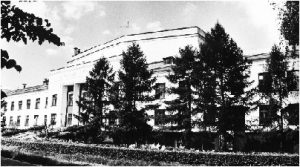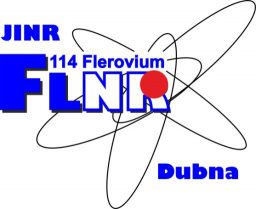FLNR history
 Further developments surpassed all expectations, and within the first decade of its existence the Laboratory contributed greatly to the rapid process of changing and renewing nuclear physics, becoming one of the world’s leaders in the field of heavy ion physics. Synthesis of a number of new chemical elements, production of scores of new isotopes near the drip-lines, discovery of three new types of radioactivity and new nuclear interactions became possible not only owing to the fact that the phenomena under study were new but also due to the unforgettable atmosphere of those first years of scientific research at the Laboratory’s accelerators. That was a result of an unprecedented freedom in the choice of new experiments, and the young age of all the Laboratory scientists, most of whom had been transferred to the Laboratory from Department 7 of the Institute of Atomic Energy, Moscow. At that time Flerov was just over 40 and the eldest researcher was under 30.
Further developments surpassed all expectations, and within the first decade of its existence the Laboratory contributed greatly to the rapid process of changing and renewing nuclear physics, becoming one of the world’s leaders in the field of heavy ion physics. Synthesis of a number of new chemical elements, production of scores of new isotopes near the drip-lines, discovery of three new types of radioactivity and new nuclear interactions became possible not only owing to the fact that the phenomena under study were new but also due to the unforgettable atmosphere of those first years of scientific research at the Laboratory’s accelerators. That was a result of an unprecedented freedom in the choice of new experiments, and the young age of all the Laboratory scientists, most of whom had been transferred to the Laboratory from Department 7 of the Institute of Atomic Energy, Moscow. At that time Flerov was just over 40 and the eldest researcher was under 30.
Naturally, over the years, different problems attracted the attention of the scientists of the Laboratory. Some of the obtained results provided a basis for quite a number of intensively developing directions of heavy ion physics at major research centres of other countries.
During 30 years Academician G.N. Flerov was director of the Laboratory created by him. Prof. Yu.Ts.Oganessian, a well-known scientist who had worked alongside G.N. Flerov, was in charge of the Laboratory from 1989 until 1996. His considerable scientific contribution promoted the development of heavy ion physics. At present he is the Scientific leader of Flerov Laboratory. In 1997, Prof. M.G.Itkis was elected Director of the Laboratory. He is known for his works in the field of nuclear fission.
At the 101st session of the JINR Scientific Council (18–19 January 2007) Prof. S.N.Dmitriev was elected Director of the Flerov Laboratory of Nuclear Reactions and held this position till 2020. He is JINR Vice-director at present. At the 127th session of the JINR Scientific Council (20–21 February 2020) Dr. S.I.Sidorchuk was elected Director of Flerov Laboratory of Nuclear Reactions.
Every two years starting from 1993 the Flerov Laboratory awards the G.N. Academician Flerov Prize for prominent works in the field of nuclear physics. The laureates of the Prize are Yu.Ts. Oganessian and V.V. Volkov of FLNR, Dubna (1993); A.A. Ogloblin of the Kurchatov Institute, Moscow, H.G. Bohlen and W. von Oertzen of HMI, Berlin (1995); S. Hofmann of GSI, Darmstadt, Yu.A. Lazarev of FLNR, Dubna, and A. Sobiczewski of INS, Warsaw (1997).
The discovery of the spontaneous fission isomerism was one of the first discoveries made at the Flerov Laboratory. Investigation of that phenomenon led to the realization that shell effects exert important influence on the potential energy of a heavily deformed nucleus. It was shown that the fission barrier of nuclei can have complicated structure with two or three humps. It was discovered that structural shell effects influence all the key characteristics of nuclear fission. It provided an explanation for the phenomenon of multimodal fission, which is one of the most intriguing and difficult-to- describe processes in nuclear physics. All these results allowed one to predict the existence of a stability island in the region of superheavy nuclei with Z=114 and N=184. Although no evidence has been found of superheavy elements occurring in nature, this problem is still agitating the minds of scientists all over the world. During investigation of the alpha-decay of the isotopes of polonium the four- quasi-particle isomeric states were discovered. Later on, investigations of multiparticle isomers, including reactions with the 178Hfm2 exotic isomeric target, formed a basis for a big international project, in which the FLNR plays a leading role.
At the same period delayed proton radioactivity and, slightly later, beta-delayed fission were discovered at the Laboratory. Both types of decay provided valuable information on the masses of nuclei far from the beta-stability line.
From the very first days, the study of topical problems of nuclear interaction, dynamics of large-scale processes, which are characterised by a radical rearrangement of nuclei resulting in the nuclear fusion or fission, occupied a prominent place in the scientific programme of the Laboratory. Investigation of the formation and decay of excited compound nuclei provided a considerable amount of information on the macroscopic properties of nuclear matter, the fission dynamics of excited nuclei. Here was discovered the mechanism of successive decay of nuclei into three fragments and a new type of nuclear reactions – deep inelastic transfer reactions. According to its properties this process occupies an intermediate position between the complete fusion reactions, which result in the compound nucleus production and quasi-elastic few nucleon transfer reactions. study of nuclei far from the beta-stability line. During the first years scores of new neutron-rich isotopes of light elements were already produced. Later on, when the problem of determining the neutron drip-line for light elements arose, there arose a need to join the efforts of researchers from many scientific centres, which permitted obtaining detailed information on the masses and structure of excited states of neutron-rich nuclei.
Throughout the entire history of the Laboratory, the main directions of research were synthesis of new heavy and superheavy elements, study of their physical and chemical properties as well as investigation of the properties of their radioactive decay. This history has been very complex – the scientists encountered numerous fundamentally new problems: the short lifetimes of the new elements, extremely low yields of the fusion reactions, on the one hand, and high yields of “side” nuclides interfering with the identification of the new elements, on the other hand. To see how extremely low the production cross section of the nuclei of new elements are, consider the following data. During prolonged irradiations the target is usually hit by about 1019 heavy ions, most of them not interacting with the matter of the target. If there are collisions, only one 1010 – 1012 th of the produced excited nuclei are the nuclei of the new element in the ground state, the rest being background products. Therefore, it was necessary to develop such detection methods which allowed unambiguous identification of a new nucleus, even if there was only one event detected. Many fundamental works have dealt with the synthesis of new elements of the second hundred of the periodic table.
Complicated experiments on synthesis of new nuclei were generally carried out at three laboratories, and not infrequently at the same time. As a consequence arose the problem of the priority of the discoveries. To solve this problem and in accordance with a joint decision of the International Union of Pure and Applied Chemistry and the International Union of Pure and Applied Physics a special working group, consisting of physicists and chemists, was established in 1986 for working out the criteria for acknowledging the discovery priority for new chemical elements. In 1995 the priority in synthesizing elements 102-105 was credited to the Flerov Laboratory. In addition, the Laboratory received a commendation for a remarkable contribution to the discovery of elements 106-108. In 1997, at the Congress of the International Union of Pure and Applied Physics, the element 105 was called Dubnium.This fact is seen as a recognition of the outstanding contribution of the international centre in Dubna to the science of chemistry and modern nuclear physics.
Reactions induced by heavy ions have become the principal tool in nuclear physics research, where 90 % of the new experimental data have been obtained with the use of heavy ion accelerators. Tremendous progress in this field is due to the fundamental importance of the obtained results and profound interrelation between nuclear physics and elementary particle physics, quantum chromodynamics, astrophysics, atomic physics and solid-state physics. Heavy ions offer ample opportunities for solving a number of major problems in various fields of science and technology. development of accelerators. At the early stage of the Laboratory’s history one of the crucial issues was to make the right choice of the heavy ion accelerator type – electrostatic, linear or cyclic. The laboratory opted for heavy ion cyclotrons. Highly reliable, simple in design and inexpensive to run, they provided high-intensity ion beams. Time showed that it had been the right choice: the ion beams produced by Laboratory’s accelerators exhibited record characteristics over many years. Moreover, a whole family of isochronous heavy ion cyclotrons, i.e. U-200, U-400 and U-400M, was created at the Laboratory. For the first time was created a tandem complex of two cyclotrons. The complex served as a prototype for heavy ion accelerating complexes based on the cyclotron acceleration method to be created later at leading research centres.
Of particular interest may be the gradual development of the research methods applied at the Laboratory over the 40 years. Progressing from the simplest methods – mechanical facilities for the transportation of reaction products, solid-state detectors and 1000-channel analysers – the scientists of the Laboratory created modern detecting systems and electronic equipment. Thus in the field of synthesis of new elements are employed two kinematic separators of recoil nuclei of very high acceptance and selectivity, which were fabricated at the Laboratory. The 4-pi spectrometer FOBOS created in wide international collaboration is completely unique.
For more information on the current status of the Laboratory, the scale of its participation in international collaboration, its scientific programme, accelerating and measuring facilities, the structure of its scientific and technical departments, its budget and plans for the future see other sections of the general JINR report.
